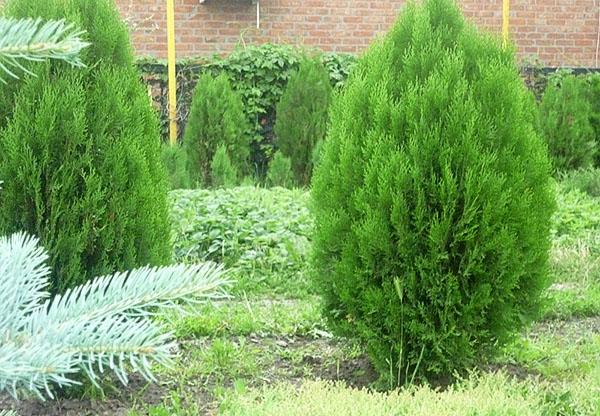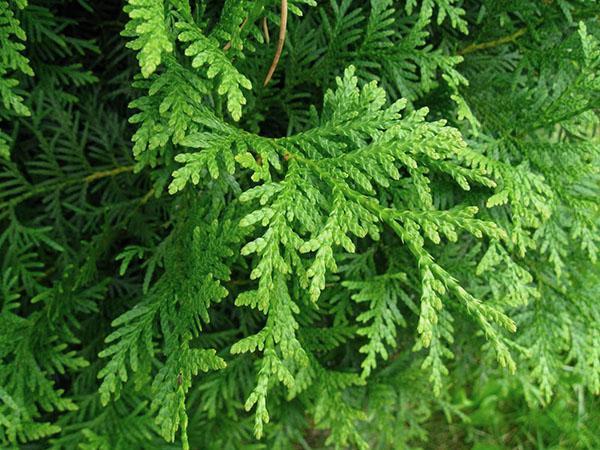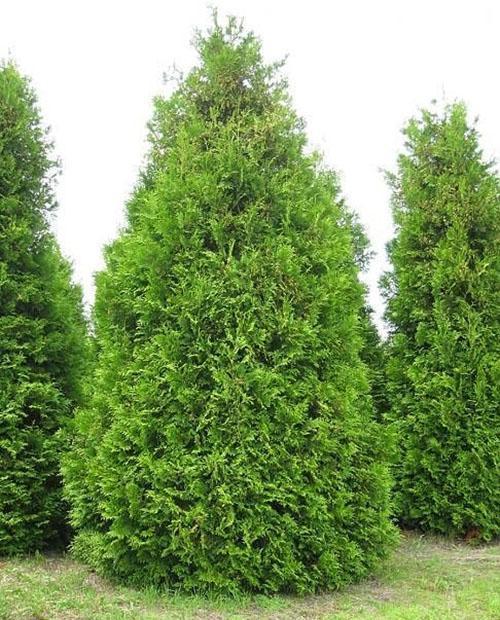Planting and care, use in the landscape design of the suburban area of thuja West Brabant
 One of the five types of thuja - western, has many varieties, among which the western thuja Brabant stands out. An ornamental frost-resistant, fast-growing tree with a compact columnar crown is widely used in landscape gardening.
One of the five types of thuja - western, has many varieties, among which the western thuja Brabant stands out. An ornamental frost-resistant, fast-growing tree with a compact columnar crown is widely used in landscape gardening.
Main characteristics

Having got acquainted with the description of thuja Brabant, we see that this variety is winter-hardy, withstands frosts up to 30-35 ° C. The plant is great for the harsh Russian climate. Brabant is one of the fastest growing varieties thuja western, for a year, the increase can be 30-35 cm.
 In the Russian climate, the height of Thuja Brabant does not exceed 3.5-4 meters. The shape of the crown is columnar, compact. Branches can bend down to the ground. The bark on the trunk is reddish brown, in places it flakes off. Green needles turn brown in winter. In April-May, thuja blooms, after flowering small oblong brown cones form.
In the Russian climate, the height of Thuja Brabant does not exceed 3.5-4 meters. The shape of the crown is columnar, compact. Branches can bend down to the ground. The bark on the trunk is reddish brown, in places it flakes off. Green needles turn brown in winter. In April-May, thuja blooms, after flowering small oblong brown cones form.
 Thuja Brabant and Smaragd are very often used for the formation of hedges. Their characteristics are largely the same. Among the differences between thuja Brabant and Smaragd can be distinguished.
Thuja Brabant and Smaragd are very often used for the formation of hedges. Their characteristics are largely the same. Among the differences between thuja Brabant and Smaragd can be distinguished.
Brabant variety:
- the needles turn brown in winter;
- the shape of the crown is columnar;
- the annual growth is 35-40 cm;
- the hedge quickly grows into a dense green wall.
Smaragd variety:
- needles do not lose color in winter;
- pyramidal crown shape;
- annual growth - 10-20 cm;
- differs in less branching and does not require frequent haircuts.
 Both varieties of thuja have varieties with golden needles - Golden Brabant and Golden Smaragd. Thuja Golden Brabant is characterized by a golden yellow color, which remains in winter.
Both varieties of thuja have varieties with golden needles - Golden Brabant and Golden Smaragd. Thuja Golden Brabant is characterized by a golden yellow color, which remains in winter.
Young trees have a dense cone-shaped crown; in old trees, it becomes looser.
How to care for thuja Brabant
 Although thuja western Brabant is unpretentious in care, it still has its own preferences for soil type, moisture, sunlight, temperature. If you neglect the basic rules when growing it, decorative functions may be lost. In particular, the main care is to periodically trim the shoots to form a beautiful crown shape.
Although thuja western Brabant is unpretentious in care, it still has its own preferences for soil type, moisture, sunlight, temperature. If you neglect the basic rules when growing it, decorative functions may be lost. In particular, the main care is to periodically trim the shoots to form a beautiful crown shape.
When cutting a thuja, you can select cuttings to use for propagation. Placed in a container of water, they will give roots. Rooted seedlings can be planted in the ground.
Place and type of soil
 Thuja belongs to light-loving plants. She does not tolerate a round-the-clock shade, losing the brightness of the color of the needles. At the same time, constant heat is also harmful to her. The best option when choosing a landing site will be partial shade. In suburban areas, it is advisable to plant trees on the west or east side of the buildings.
Thuja belongs to light-loving plants. She does not tolerate a round-the-clock shade, losing the brightness of the color of the needles. At the same time, constant heat is also harmful to her. The best option when choosing a landing site will be partial shade. In suburban areas, it is advisable to plant trees on the west or east side of the buildings.
The most favorable soil for cultivating thuja in western Brabant is loam, although it can grow on any soil. On light soil, the plant develops better and looks more decorative. Plant thuyu preferable in spring or autumn, but also possible in summer.
Landing
 A planting pit is dug with a depth of 60-80 cm, width for the size of the root system. The pit is filled with water and moisture is allowed to be absorbed. If the soil is heavy, at least 15 cm of drainage layer is required. The root collar is placed at ground level and the seedling is covered with a prepared soil mixture. It is desirable that it includes peat, sand and leafy earth in a ratio of 1: 1: 2. To improve growth, nitroammofoska is added to the mixture. After that, the plant is watered.
A planting pit is dug with a depth of 60-80 cm, width for the size of the root system. The pit is filled with water and moisture is allowed to be absorbed. If the soil is heavy, at least 15 cm of drainage layer is required. The root collar is placed at ground level and the seedling is covered with a prepared soil mixture. It is desirable that it includes peat, sand and leafy earth in a ratio of 1: 1: 2. To improve growth, nitroammofoska is added to the mixture. After that, the plant is watered.
Care
 After landing, regular watering, about once a week. When planting in hot weather, the frequency of watering increases. The plant responds well to sprinkling. You can use a spray hose for this. In dry soil, thuja develops poorly, the needles turn yellow and crumble.
After landing, regular watering, about once a week. When planting in hot weather, the frequency of watering increases. The plant responds well to sprinkling. You can use a spray hose for this. In dry soil, thuja develops poorly, the needles turn yellow and crumble.
The soil should be loosened to a shallow depth, since the plant has a superficial root system. To protect the roots from drying out and overheating, it is advisable to cover the soil with mulch - peat, compost, sawdust, bark.
Thuja does not suffer from winter frosts, but in the spring it can get sunburn. Young trees should be especially protected by covering them from the sun with a material that transmits sunlight well. In an evergreen plant, the process of photosynthesis occurs even in winter. In places where heavy snowfalls occur, tree crowns are tightly pulled together with a rope for the winter.
In the first year, while the roots are not strong enough, feeding is carried out up to three times per season. A year after planting, every spring they feed complex fertilizer... Pruning is best done 2-3 years after planting. It is preferable to do this procedure twice - at the beginning of summer and at the end of August. Small crown adjustments are made throughout the season. As you can see, planting and caring for Thuja Brabant (photo) is not particularly difficult.
The use of thuja Brabant in garden design
 The advantage of the variety is that it grows very quickly. This is thuja Brabant's property landscape design used successfully. Thuja is a versatile element for creating a single ball, neat cone, pyramid. Non-standard single figures made of wood can be planted with any surface relief. But if beautiful geometry from Thuja Brabant or Smaragd is planned, then the landing area should have a perfectly flat plane.
The advantage of the variety is that it grows very quickly. This is thuja Brabant's property landscape design used successfully. Thuja is a versatile element for creating a single ball, neat cone, pyramid. Non-standard single figures made of wood can be planted with any surface relief. But if beautiful geometry from Thuja Brabant or Smaragd is planned, then the landing area should have a perfectly flat plane.
Thuja western Brabant is best cut on cloudy days. This will prevent young shoots from burning in the sun, which were hidden under long branches before cutting.
Thuja planted in a row will replace the hedge. If you cut such a fence into a rectangular shape, it looks completely different. When planning to grow a hedge from Thuja Brabant, the seedlings should be dug in at a distance of about 1 m from each other, because the crown will be wide enough at the base. Over time, the crowns of the trees will close, and such a hedge with a dense green curtain will cover the area from prying eyes and serve as a wonderful decoration.
 The plant begins to form when it has reached the desired height. Pruning thuja Brabant is the most time-consuming part in caring for a plant. The haircut is sharp secateurswhich will not be able to make dents in the place of the cut. So that the tree does not weaken, a third of the shoot should be cut.
The plant begins to form when it has reached the desired height. Pruning thuja Brabant is the most time-consuming part in caring for a plant. The haircut is sharp secateurswhich will not be able to make dents in the place of the cut. So that the tree does not weaken, a third of the shoot should be cut.
Thuja Brabant, like all conifers, will delight the whole year with lush greenery, purify the air, enriching it with oxygen. Another advantage is decorativeness. By combining various types of thuja with other shrubs and flowers, you can give the site a unique, inimitable shape.